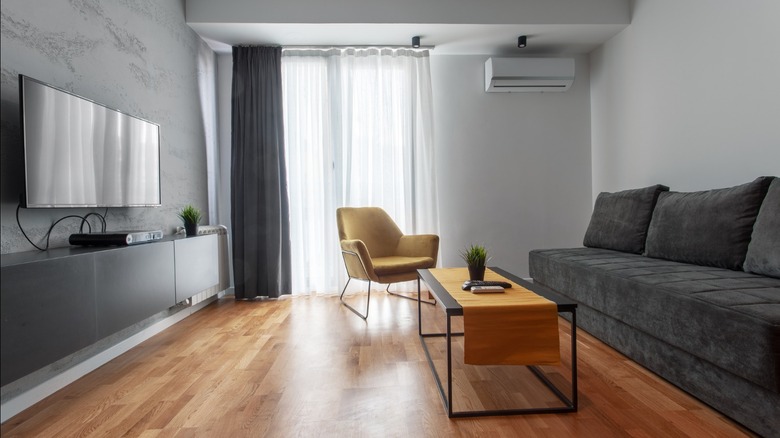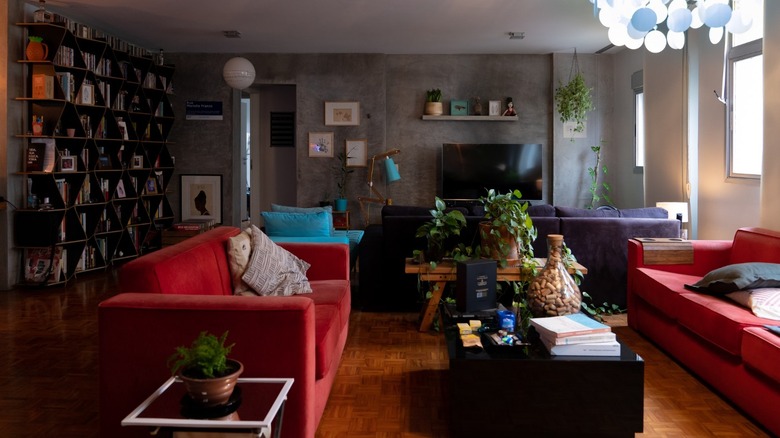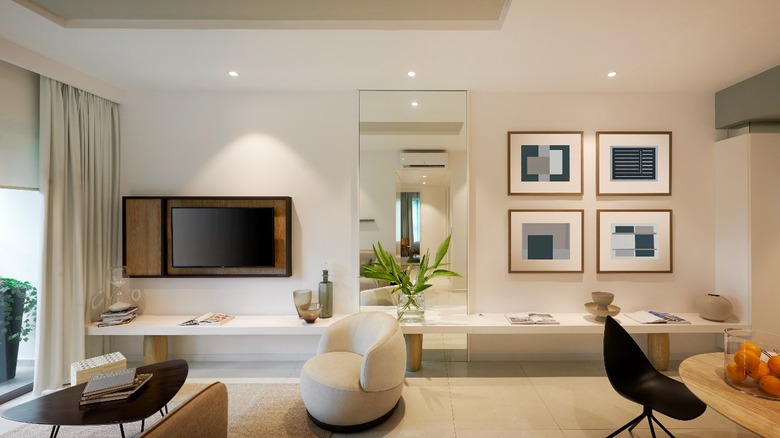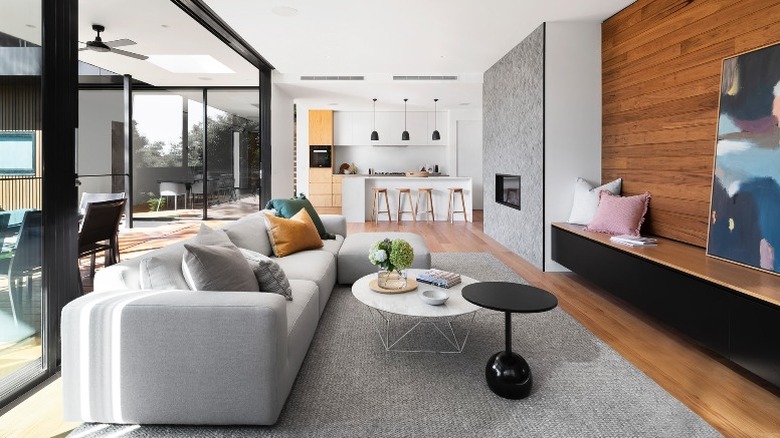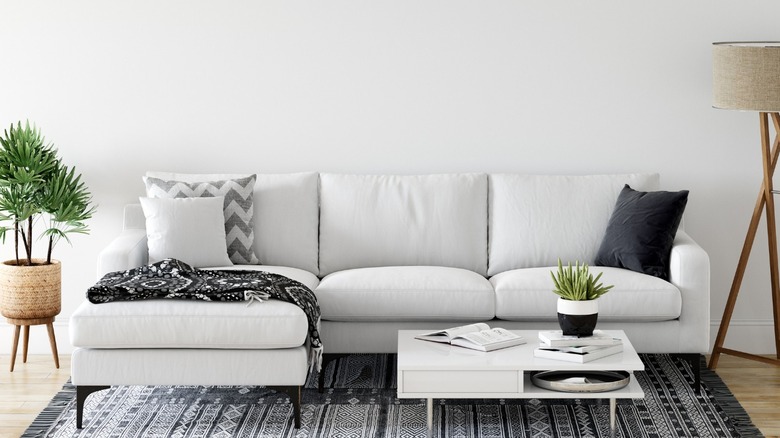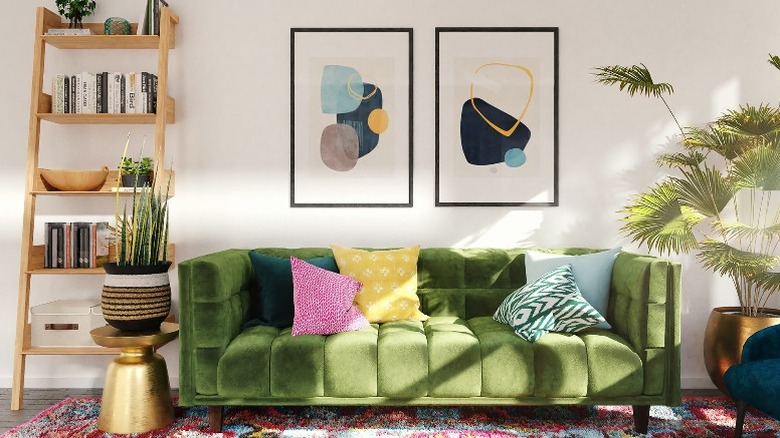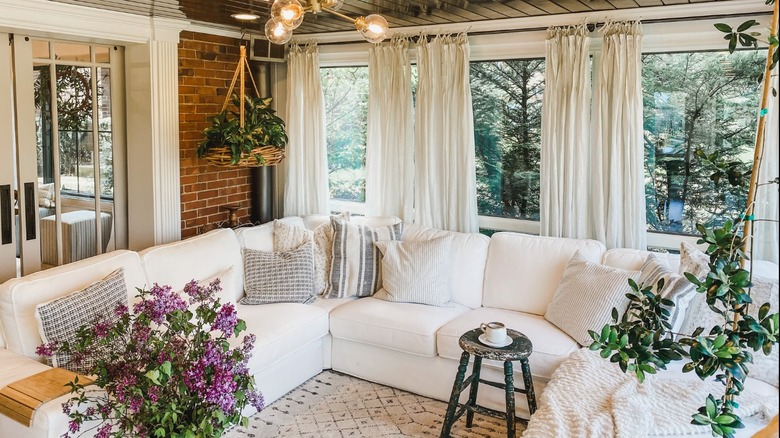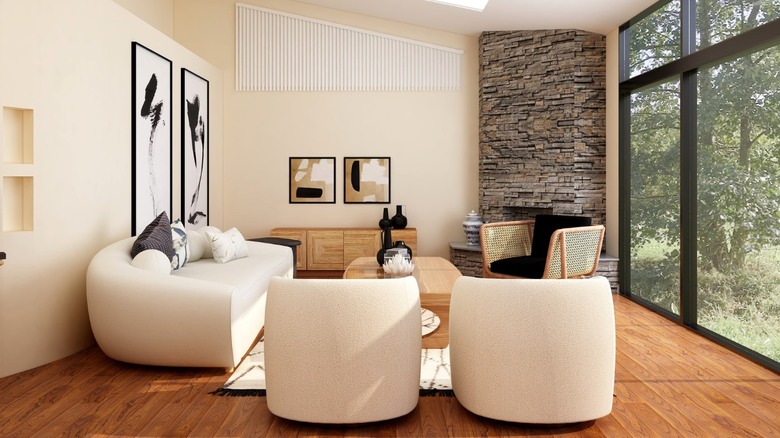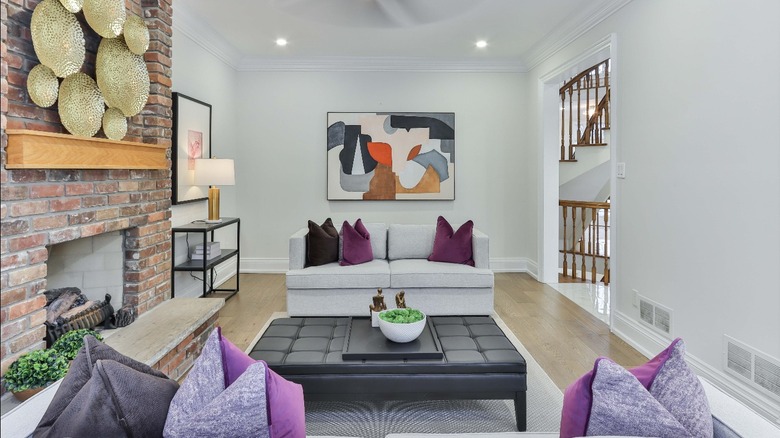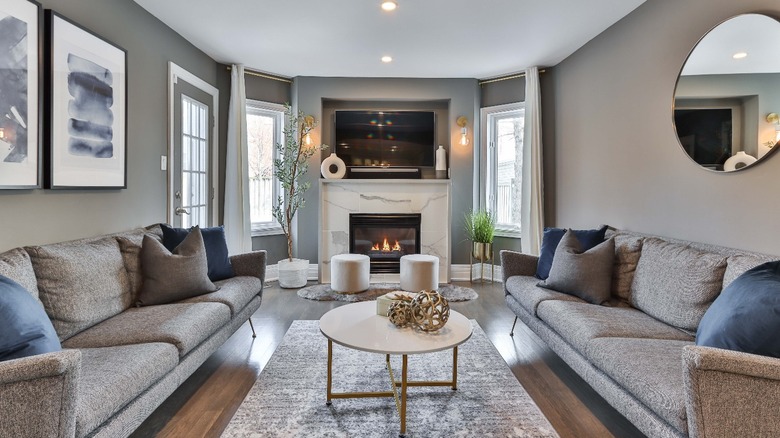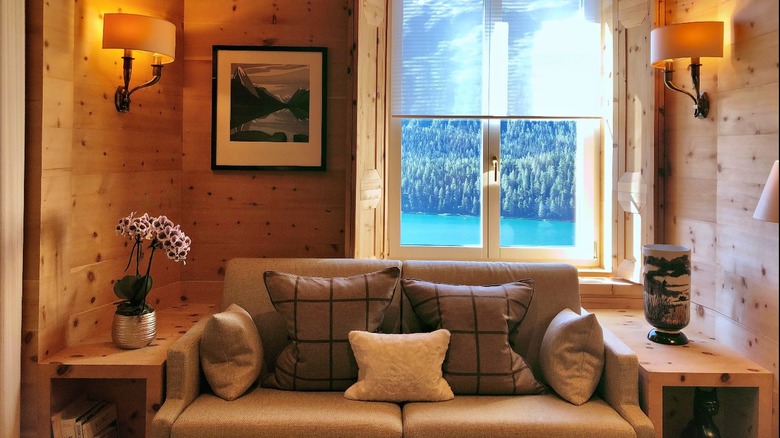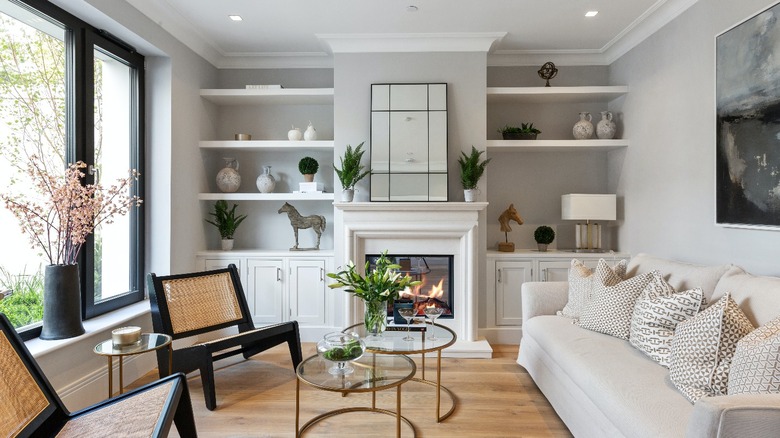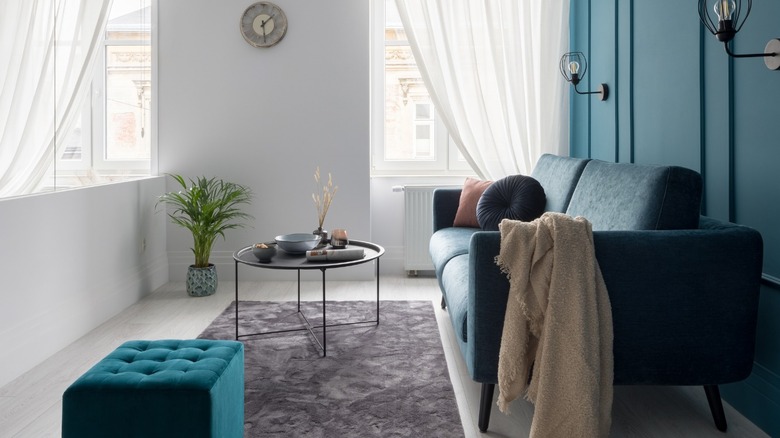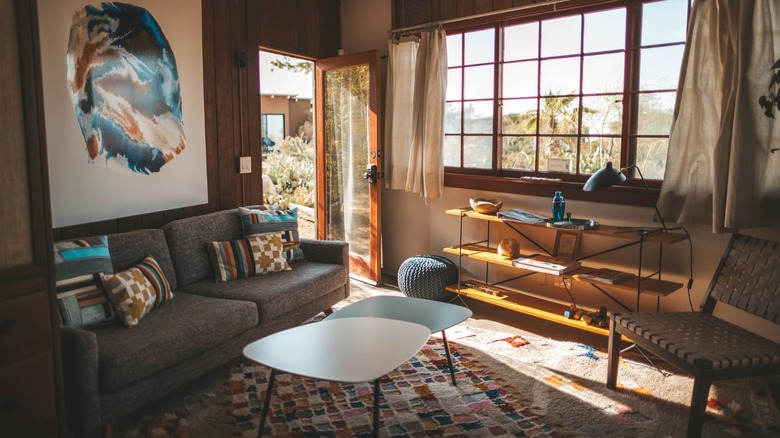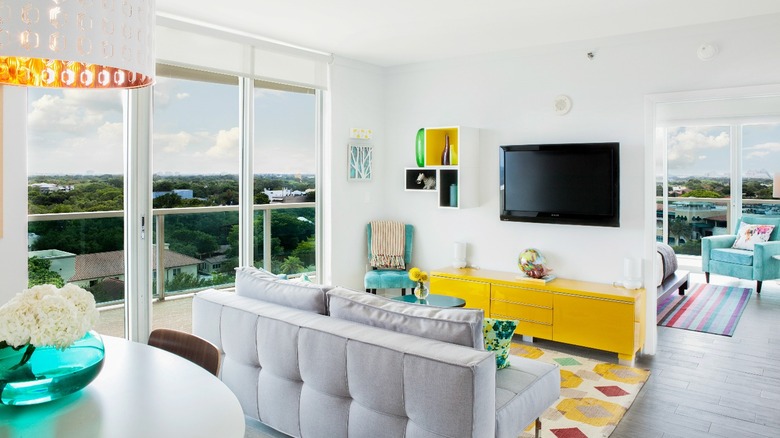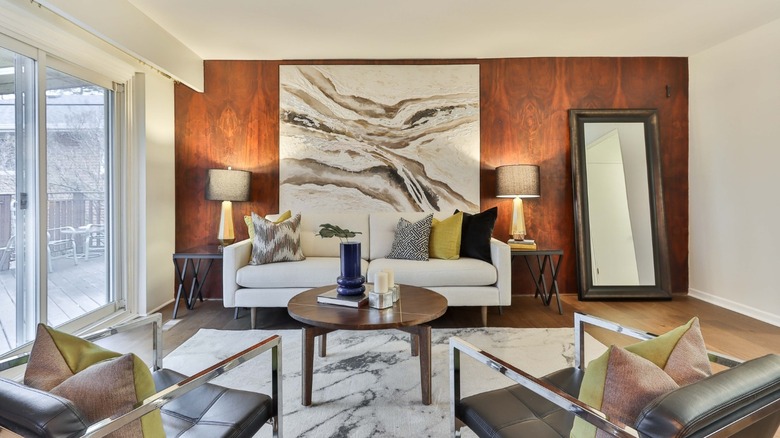15 Ways To Design A Small And Skinny Living Room
An elongated room can pose a real design challenge, but to talented decorators, it's often seen as a unique opportunity. If you can recall a particular space as striking, chances are it was different, making you feel somehow special, maybe even magical. Strange places are sometimes destined to become stunning, partly because the imagination required to transform them is admirable and delightfully bewildering.
A long and narrow living room is not conducive to easy or conventional furniture arrangements and requires thinking outside the box. Homes & Gardens suggests a few clever illusions to trick the eye or distract it from a direct path of one end to the other, including creating separate areas, pulling furniture away from walls, and choosing properly scaled furniture. Playing the dimensions for drama is an alternate approach. We recommend you embrace the straight and narrow while being a bit of a decorating deviant. We'll show you how.
1. Create separate seating areas
A long, narrow space can be broken into several areas or functions, creating intimate and useful arrangements; this is frequently a solution in rooms where a fireplace and TV both vie for attention. A TV viewing lounge, conversation spot, reading nook, and game pod are all great ways to think about the division of the space. Area rugs, furniture, light fixtures, and wall décor can help delineate one area from another visually.
2. Use mirrors to open the space
Mirrors are efficient means of décor — the ultimate multiplier. They reflect light back into the room and are the particular reason they were used before electricity to back wall sconces. Second, they also fool the eye into believing there is more square footage than it actually is in the space. And third, they function as wall décor, providing an interesting backdrop and sometimes a demarcation from one focus to another.
3. Save space with banquettes
Banquettes are built-in seatings along a wall; generally paired with breakfast tables, they are useful anywhere there's a need to save space and especially suited for narrow layouts. Informed by the function in boat-building, they often provide the added benefit of hidden storage — an essential method for making a home feel clutter-free and in ship shape. Throw pillows add comfort, color, and print.
4. Use flooring and rugs to trick the eye
Optical illusions are fun games — remember the example of two exactly measured straight lines, one capped to become an arrow, the other with the ends flipped opposite? The arrow looks absolutely lithe in comparison to its stout counterpart. Flooring works the same way; hardwoods or carpet stripes that run the direction of the room will make it appear longer while cross-cutting the space or running them diagonally changes the perception. Larger scale tiles or rugs with oversized patterns can have the same effect.
5. Distract with bold design
Color, pattern, and personality all distract from a small space. The keys to not implementing an overwhelming design are balance and clean sight lines — a few items on the floor, furniture with high legs, and ample places for the eye to rest will help convey a tidy aesthetic. In grandmillennial style, traditional pieces, maximum color, and a profusion of prints are popular, and they're absolutely fine in a tight room. However, minimal space doesn't have to equate to minimalism.
6. Sectionals for the win
Sectionals are extremely well suited to small spaces. They fill the corners and allow more seating in the same square footage than a separate sofa and love seat; additionally, the continuous line looks cleaner than mixed pieces. It's imperative to take accurate measurements and assess the best placement in the room, as its arrangement may be limited to one orientation. Sectionals have become popular recently because they convey a laid-back and casual style that supports how we live in our homes.
7. Swivel chairs save face
Swivel chairs easily turn to face any desired direction, making them ideal for the center of a room that's broken into multiple seating areas or has various focal points. As a plus, their scale is frequently smaller, with a lower back that won't block the sight line in the space. Further, the availability of an abundance of textiles, colors, and prints provides an opportunity to create an affordable design statement.
8. Keep it light
As a general rule of thumb, light paint colors help to make a space feel more expansive, especially if additional elements in the room are also bright. In this narrow living area, white walls, ceiling, molding, sofas, and the area rug carry the eye throughout; the hardwood floors are also relatively light in value. The attention getters become the textural fireplace and rich accent colors, not the meager dimensions of the room.
9. Double sofas are twice as nice
A sofa offers the largest amount of and coziest seating in the living room, where usually three or more can sit comfortably. Double sofas are even better, especially in a narrow footprint, lining the perimeter walls for the utmost in efficient space planning. Opt for clean-lined pieces with smaller arms and high legs, and ensure there is enough clearance between them and the coffee table. A chic, loungey feel reminiscent of a luxury hotel lobby is imparted with facing sofas. Who wouldn't want that for their living room?
10. Play to its strengths
If you can't disguise something, make it so obvious we forget to notice! You can treat a jewel-box room with greater luxury than a normally-sized space in regard to both effort and expense. It's the perfect place to splurge on a high-end wall treatment or plush designer rug, and sometimes remnants are available, making it even more affordable. The attention to detail and richness celebrate its dimensions, affecting an intimate and unusual experience for those in the space.
11. Built-ins are a great idea
Hidden storage in a home is an unsung luxury, and it's particularly necessary for small spaces. Not only does a wall of built-in cabinetry provide a place for everything, but it also creates a focal point and an opportunity to display favorite décor. Moreover, in a long narrow room, built-ins are a perfect utilization of the space on a short end, making a logical purpose of the available depth and affording plentiful function.
12. Ottomans and daybeds
Ottomans and daybeds are perfect in small or narrow spaces for several reasons. They provide extra seating without the high back of a chair that stops the eye from moving throughout the room or blocks its attributes; for example, they are ideal in front of a fireplace or low window. Ottomans can be tucked underneath console tables and tall coffee tables, saving floor space, and they offer the chance to introduce round shaping and the softness of additional fabrics in a hard-edged room.
13. Oversized artwork
One statement art piece can help create a clean, impactful room design. In this space, the oversized art unifies several elements, including the color scheme, accent pillows, area rug, and even the woodwork, while the large canvas keeps the room from feeling cluttered and anchors the sofa below. Alternate options for artwork are a standing screen placed behind the sofa or a tapestry.
14. Dinner and a show
Create multi-function and, therefore, extra space with the addition of small dining set in the living room. Perfect for eating dinner while watching a movie or breakfasting with the news, it's also a nice spot to read with a cup of tea. Additionally, it can be a home-office location or a puzzle or project table. Pick a shape that fits the room's dimensions best — choosing a round may be an easy way to add some softness to the design.
15. Arrest the eye with an accent wall
Use paint and wall treatments to change the perception of an elongated space. For instance, a medium tone on one, or both, of the room's short walls will bring them forward, making the dimensions feel more in balance. This can be accomplished via contrasting paint, wallpaper, or drapery; a large piece of artwork serves the same function.

